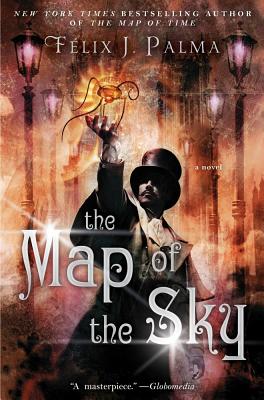by Felix J. Palma
Those who read Felix J. Palma’s The Map of Time are well
aware of the author’s hijinks and trickery.
Be forewarned, he is again up to his clever tricks—though not, perhaps,
exactly the ones we’ve seen before. No,
this is a writer who will keep readers on their toes!
So, about The Map of Time… You should read it before you even think of
picking up this book. For a long while,
I thought it would be unnecessary, but as I got deeper into the novel, it
became obvious that you’d be missing much without having read the first volume
in the trilogy. And if The Map of Time
is Palma’s homage to H.G. Wells’ The Time Machine, then The Map of the Sky is
his homage to The War of the Worlds (as well as other early science fiction
classics).
This second volume is similarly structured. It’s told by the same omnipotent narrator
about whom I desperately hope to learn more in the final volume! This unnamed voice is a major presence in the
story he tells, with remarks like: “What
happens next is hard to describe.
Perhaps a more seasoned narrator would have no difficulty—I am thinking
of Wilde or Dumas—but unfortunately it falls to me.” And, “I hope you will forgive me for having
left our hero in such a delicate situation; think of it as my homage to the
serialized novels of the time.” Yes,
that kind of intrusiveness can grow precious, but Palma walks a delicate
balance and really pulls this device (as well as the literary equivalent of
breaking of the fourth wall) off terrifically well.
Also like the prior novel, The Map of the Sky is told in
three parts, each of which is a distinct, but linked story. And again, author H.G. Wells, plays a role in
each. The dire events of this novel are
kicked off innocuously enough, as Wells meets an American hack writer for a
liquid lunch. When his counterpart
offers to show him a real Martian, how can Wells resist? The story rapidly moves from the preserved
specimen in the British Museum to the events many years earlier that led to the
collection of the museum specimen. This
first section is a harrowing tale of Antarctic adventure.
The second section of the novel brings Wells back to the
center of the story, and reintroduces a character from the last book in a new
guise. Identity is a tricky business in
this novel. It’s that magician’s
misdirection; never assume you know who anyone really is. Oh, that Palma is a delight! The second part of the novel involves a
Martian invasion of London much as Wells wrote in his novel a year prior. This alone makes him suspect and brings a
Scotland Yard inspector into the tale.
But what at first appears to be a hoax quickly turns far darker than
expected. Always Palma defies
expectations.
The third part of the novel takes place two years later,
and here the story again revisits a secondary character from The Map of
Time. In this section, his tale is the
center of the story, but it serves to move the whole narrative towards its
terrifically satisfying and pitch-perfect conclusion.
If the novel has a weakness, it is that at 608 pages, it
may be a tad overwritten. I think this
is largely due to Palma’s writing in Victorian style. Why use 100 words when you can use a 1,000? Despite the occasional excess, the story
moves along rapidly and it was torture to put the book down. The one other criticism I’d noted after
reading more than half the novel was a failure to connect with the characters
emotionally in more than a superficial sense.
Well, Palma had me eating those words, and in the latter part of the novel
he delivered big time.
This trilogy has proven to be a pure delight. Mr. Palma has left ample clues about which of
Wells’ novels will be featured in the final volume, so I’ve got some reading to
do before next summer. I can’t wait to
see what he delivers next.
And finally, I will leave you with a quotation,
completely out of context, just because I like it so much:
“Grieving for the death of beauty is a very human idiosyncrasy. Do you know, Mr. Wells, when a star dies, the light from it goes on traveling through space for thousands and thousands of years? The universe remembers for a very long time whatever dies, but it doesn’t grieve. It is natural for things to die. Yet I’ll grieve for you when you’re gone, for the beauty you are capable of creating, sometimes unconsciously. I’m sorry I can’t offer you greater solace, the solace a priest offers his flock. But all of us are subject to the laws of the cosmos.”


I just finished The Map of Time and absolutely loved it! Thanks so much for bringing up this sequel, as it compelled me to finally get around to the first novel. Here's my very brief review of it on goodreads: http://www.goodreads.com/review/show/205036984
ReplyDelete